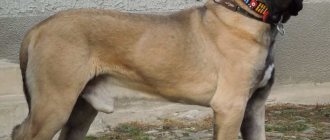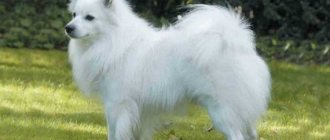History of the breed
The Pomeranian's homeland is Germany, namely the northern Prussian province of Pomerania. From this place comes the name of the breed - Pomeranian Spitz. Once upon a time, a long time ago, the ancestors of the modern Spitz were not so small. Only in 1870 did English dog breeders begin to work on the miniaturization of these animals. Today, the Pomeranian species holds the lead among all varieties of Spitz in beauty and miniature size.
Trying to emulate the Pomeranian Spitz from England, breeders from different countries began to modify their Spitz, trying to bring them as close as possible to the English standard, which was rapidly conquering the world. Having reached England from Pomerania and transformed for the better, the dwarf Spitz went to America. It was in America that the name “Pomeranian Spitz” was firmly established, and the popularity of these lap dogs skyrocketed at lightning speed.
Coat color
If earlier Pomeranian Spitz were only white or sandy in color, now, through selection, representatives of the breed with a red coat color have appeared. It is important to know that the coat of such a dog is thick and luxurious, and therefore requires special attention and care. Currently, you can find the following colors of oranges: cream, blue, white, orange, sable, brown, rich red and black.
We suggest you read: Uterine bleeding in a cat, causes, symptoms, treatment
Many people prefer to have white dogs. However, a pure shade without blemishes is quite difficult to find.
But what colors does the standard allow? The Pomeranian Spitz is divided into three groups according to its color, into which they are distributed at specialized exhibitions. The first is Pomeranians, which have sable, cream or orange shades of fur. The second are individuals with a black, blue or brown color.
Breed standard
A distinctive feature of the Pomeranian Spitz breed is its unique coat. It's not about the length, although that adds beauty. The main thing is that the hairs stand perpendicular to the body, all due to the fact that there is an abundant undercoat. You can't help but like these extraordinarily beautiful dogs with cute faces. It seems that everything about this animal is beautiful, the breed standard is proof of this.
The head is small in size, wedge-shaped, and rests on a medium-length neck, which visually seems too short due to the fluffy scruff. The small ears are set high and close to each other. Shaped like triangles with sharp tips. The forehead is rounded. The dark eyes are oval, small, set slightly obliquely. The muzzle is small, the nose is also small, black or brown. Scissor bite (the upper teeth duplicate the lower teeth).
The body is well developed, the back is short, the ribs are rounded. The chest is deep and wide. The limbs are straight, with well-developed muscles. Paws are rounded.
A very fluffy, luxurious tail in the form of a ring is thrown over the back. It is not too long, set high.
The Pomeranian's coat is extremely beautiful. It is lush, but does not form voluminous collars. There are only fringes on the forearms, and fluffy “pants” on the limbs. Thanks to the short but very dense undercoat, the guard hair is hard and straight, standing perpendicular to the body. At the age of three, the Spitz's coat is completely formed. According to the standard, wavy, curly, shaggy hair is not allowed. Also, it should not be parted on the back.
The color of the Pomeranian Spitz can be ten different colors, there are two-colored individuals. All shades of the main coat color are found. If the Spitz is spotted, then the spots are distributed throughout the body. Among the variety of colors of this type of dog, everyone who is planning to buy a puppy will be able to choose their own option. Pomeranians can be: cream, white, black, blue, sable, black and tan, chocolate, orange, blue and tan, two-color.
Spitz color: what to look for when choosing a puppy
The colors of Spitz dogs depend on the colors of their ancestors. When choosing a puppy, you should definitely inquire about the color of its parents, as well as all its known relatives. This will increase the chances of choosing a dog with a color that meets the requirements of the standard. After all, if a puppy has ancestors with a different color, he may develop tan marks or spots of a different color after some time. Spitz puppies' colors can change after their first shedding. For example, the color of a black Spitz puppy may initially be dark gray.
To understand what the pet's color will be, you need to carefully examine the fur behind the puppy's ears. This is exactly what his color will be when he grows up, but this method does not provide a 100% guarantee. If a puppy is purchased for participation in exhibitions, then it is better to reserve it and pick it up after the first moult, when the color has finally appeared and will no longer change.
We suggest you read: Why does a pregnant cat have bleeding and what to do?
Maintenance and care
From the first day the puppy arrives at your home, show him his place with a bed and various toys. It is important to immediately accustom your pet to this place; if you let the dog onto your bed once, it will be difficult to drive him away from there; he will try in every possible way to sleep next to you, and not in his place.
Instead of a bed for such a small dog, you can easily buy a whole dog house. You need to determine a place for your pet in a quiet, non-traversable part of the house, where it is not too noisy, there are no drafts, where it is not hot and not cold. If the dog decides to relax in his small territory, he should not be disturbed; he should feel completely safe in his house.
Having sorted out the sleeping area, decide where you will feed the dog. In most cases, bowls for water and food are installed in the kitchen, but this is not at all necessary, everything is at the discretion of the owner. It is recommended to buy dishes together with stands and fastenings. This will prevent the dog from knocking over the bowls or moving them. In addition, such a corner for feeding a pet looks much better than just two containers for drinking and food.
The Pomeranian Spitz is a very active and energetic animal, but due to its small size, the dog, after running around from room to room, can fulfill the daily requirement of physical activity. This does not mean that a tireless dog does not need walks. He loves to walk; even a long trip in the fresh air will not tire him. So you don’t need to limit yourself to a diaper or toilet tray. It is better to accustom your pet to daily walks, which should last at least 30-40 minutes. During walks, give the animal the opportunity to play outdoor games, give him tasks that the dog will be happy to complete.
Because of its curiosity, the Pomeranian can get into dangerous situations. Representatives of the breed are known for their fearlessness, so the owner should not let the Spitz off the leash while walking if the area is without a fence. You also need to carefully monitor your pet if there are stray animals or large breed dogs nearby.
When caring for a Pomeranian, the most difficult part is caring for the coat. Representatives of the breed shed heavily; during this period they need to be combed every day. The rest of the time, 2-3 times a week is enough. Without such procedures, the spitz's beautiful coat will become tangled and tangles will form on it, which are practically impossible to deal with. Particularly difficult areas are on the hips and behind the ears.
In order for a Pomeranian to look well-groomed and beautiful, grooming is needed; its variety cannot but please. An experienced specialist will be able to make a “fox”, “lion cub”, “bear cub” out of your dog, or simply turn a Spitz into a fluffy ball.
Ordinary hygiene procedures for a dog will not take much time from the owner:
1. Bath once every six months. Since the Pomeranian's skin is prone to dryness and dandruff, use dry shampoo or mild shampoo in tandem with conditioner when bathing. 2. Trim the claws as they grow, this must be done very carefully so as not to injure the animal. If you have no experience, entrust this procedure to a specialist. 3. Inspect and clean your ears once a week. If you notice excessive accumulations of ear discharge, take your pet to the veterinarian. This phenomenon may indicate the presence of an infectious disease. 4. Wipe your eyes with swabs soaked in a special liquid 2-3 times a week. 5. Brush your teeth regularly, using toothpaste or buying bones specially designed for cleaning teeth.
You might find our article useful: Daily dog eye care. How not to miss a disease
Nutrition
It is important to feed your dog properly from puppyhood. Nutrition should be balanced. It is recommended to prepare the diet together with a veterinarian who conducts preventive examinations of your pet.
It is important to adhere to the following rules regarding feeding the Pomeranian:
- Puppies, depending on their age, are given food 3-6 times a day. The smaller the puppy, the more often he should eat and the smaller his portions should be.
- Adults are given food 2 times a day.
- Half of the diet should consist of meat and protein products. The basis is beef and chicken.
- Cook porridge from buckwheat, rice and rolled oats.
- Feed low-fat sea fish 1-2 times every 7-10 days.
- Boiled and raw vegetables are useful.
- It is forbidden to give bones; they are dangerous for small breeds.
- Lamb and beef cartilage are suitable as “candy” for puppies. This treat serves as a source of minerals and also promotes jaw development.
- During the spring shedding, your dog requires vitamin supplements.
In general, the Spitz is unpretentious in food, but this does not mean that you can feed it somehow. Don't forget about the animal's need for water. The dog should always have a bowl of clean and cool water available to him, and it should be changed frequently.
Health
Every Pomeranian owner should know what health problems are most common in their pet:
- Hypothyroidism is a pathological condition that develops due to a long-term lack of thyroid hormones. During the treatment process, the main task is to normalize the functioning of the thyroid gland. For this purpose, drugs are used to replenish the deficiency of thyroid hormones.
- Atlanto-accipital subluxation - treatment can be conservative, but the need for surgical intervention cannot be ruled out. The outcome is quite difficult to predict.
- Cryptorchidism is the failure of one or both testicles to descend into the scrotum in male dogs.
- Medial luxation of the patella is a congenital pathology, the treatment of which may require surgical intervention.
- Sick sinus syndrome is a cardiovascular disease. The animal may lose muscle control.
- Eye diseases - cataracts, eyelid deformities, progressive retinal atrophy.
- Tracheal collapse is difficult to diagnose initially, as a sudden cough may not cause concern to the owner. This disease can be fatal.
- Difficulty giving birth – Most small breed dogs experience difficulty during birth due to their small size. For a successful outcome, a caesarean section is prescribed.
If you have the slightest suspicion of a particular disease, you should not self-medicate. Only a veterinarian should determine the diagnosis and prescribe medications. It is also important to vaccinate on time and show your pet to a specialist for preventive examinations. With proper care, a Pomeranian can live up to 13-16 years.
Why can a dog be immediately disqualified?
- For malocclusion;
- Crown that is not overgrown;
- Eversion or inversion of the eyelids - unfortunately, this defect is difficult to correct;
- Ears that have a semi-erect position;
- White spots on fur. Whatever the color, bright white spots should not be observed.
Conclusion
Author's opinion
Ask a Question
From time immemorial, Spitz dogs, thanks to their cute appearance and friendly disposition, have been the favorites of both the powers that be and ordinary citizens. This is probably why the standard of this breed was carefully passed down from generation to generation.
Character
When you look at a Pomeranian, it seems that he is smiling. This is explained by the structure of the animal’s muzzle, but it completely coincides with the disposition and character of this miniature dog.
The Pomeranian is an optimistic, cheerful, cheerful dog. From the first minutes she puts you at ease, you want to play with her and stroke her fluffy fur. It is interesting that this animal combines uncontrollable activity and indestructible calm. A Spitz is capable of chasing a ball for a long time, running, jumping, but if circumstances require it, the pet can sit quietly in the arms of its owner for several hours in a row. So it’s not scary to go on a trip with such a dog; it won’t cause any problems. If you don’t want to hold her in your arms all the time, place the dog in a carrier bag.
The Pomeranian is ideal for lonely people, as it is ready to be with its owner 24 hours a day. A dog will also get along well in a family where there are teenage children who love animals and who know how to treat them. The Spitz is not very suitable for families with small children. Children can injure such a small creature, and a Spitz, due to poor treatment, can turn into an angry, nervous dog.
One of the character traits of representatives of this breed is their tendency to bark for no reason. At the same time, the dogs are also distinguished by their ringing voice. This can create inconvenience for both the owners and their neighbors. You can make a dog well-mannered, but you need to start fighting excessive barking from puppyhood. It is interesting that with such behavior the pet strives to attract attention to itself, and not to scare others.
In the first months of life, the Spitz is peaceful towards all pets. With age, the desire to dominate begins to appear. Surprisingly, a small dog without hesitation is able to rush with a loud bark at a huge dog, especially in comparison with him.
Training and education
Teaching your Pomeranian the rules of exemplary behavior at home and in public places is not at all difficult. Gradually instill this knowledge in your puppy; a Spitz is an intelligent animal that can sense the mood of its owner. You just need to tame his desire to dominate and his stubbornness.
During training and education, you should not shout at your pet, and under no circumstances should you hit it. Such methods will in no way contribute to the fastest learning results. Patience and perseverance are the main rules of behavior in the educational process. Your pet will quickly learn simple commands and small tricks.
Pros and cons of the breed
Owners of Pomeranian Spitz are well aware of all the advantages and disadvantages of the breed. Such knowledge helps to combat shortcomings and find ways to get along with them if it is not possible to eradicate them. If you are planning to purchase a decorative dog of this breed, you should familiarize yourself with the information below:
Advantages of the Pomeranian Spitz breed:
1. Loyalty to his master. 2. Cheerfulness, playful and cheerful disposition. 3. The ability to adapt to both heat and cold. 4. Excellent hearing. 5. Good health. 6. Endurance. 7. Cleanliness. A Spitz, like a cat, often licks its fur for a long time, bringing it into proper shape. 8. Get along well with other animals.
Disadvantages of the Pomeranian breed:
1. Heavy shedding. 2. Unreasonable loud barking. 3. The desire for dominance. 4. Bite problems.
The advantages are half as many as the disadvantages. In addition, it is quite possible to cope with all the listed disadvantages. Excessive barking will not be a nuisance if the dog is raised correctly from birth, the coat is carefully combed every day during the shedding season, dominance is eliminated through proper training, and bite problems are resolved by a veterinarian-dentist.
How long do Pomeranians live?
Spitz , like most small dogs, is a long-lived breed . The average life expectancy is 12-16 years . The key to a pet's longevity is good care and proper nutrition.
And we are not just talking about proper care in medicated dog food, although they are very important. The Spitz is dependent on human attention , he needs a lot of communication, more walks, runs, and games.
Even when the dog is 8 or 10 years old, do not classify it as an oldie, spend the same active leisure time with it as before. There are cases where Spitz dogs lived up to 20 years and remained just as restless and vigorous.











